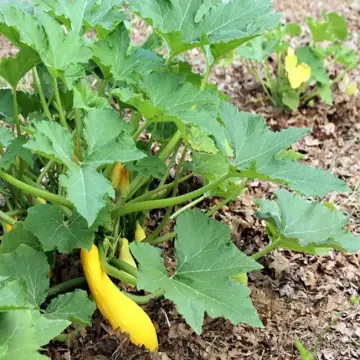Yellow Straightneck Squash (Cucurbita pepo) is a popular summer squash variety known for its bright yellow skin, slender neck, and mild flavor. It’s a staple in many home gardens due to its ease of growth, productivity, and versatility in the kitchen. Here’s a guide to growing Yellow Straightneck Squash in your home garden, from planting to harvesting.
Introduction to Yellow Straightneck Squash
Yellow Straightneck Squash is a warm-season vegetable that thrives in well-drained soil and full sunlight. It’s often used in sautéing, grilling, and baking and can be a part of various dishes, such as casseroles and salads. Unlike its cousin, the crookneck squash, this variety has a straighter neck, making it easier to slice and prepare.
Planting Yellow Straightneck Squash
Yellow Straightneck Squash can be grown from seeds or transplants. Here's how to get started:
- Soil Preparation: Choose a sunny location in your garden that receives at least 6-8 hours of direct sunlight. The soil should be well-draining with a pH between 6.0 and 6.8. Amending the soil with compost or well-rotted manure will provide the necessary nutrients for healthy growth.
- Seed Planting: If starting from seeds, plant them directly in the garden after the last frost date. Sow the seeds about 1 inch deep and 24 to 36 inches apart in rows, or plant them in mounds or hills with three to four seeds per hill, spacing the hills 3 to 4 feet apart.
- Transplants: If using transplants, wait until the soil has warmed to at least 60°F. Space the transplants similarly to seeds, ensuring that they are not overcrowded.
Growing Tips
Yellow Straightneck Squash is relatively low-maintenance but benefits from the following growing practices:
- Watering: Water consistently, aiming to keep the soil evenly moist but not waterlogged. Avoid overhead watering to minimize the risk of fungal diseases. Drip irrigation or soaker hoses are ideal for this plant.
- Mulching: Apply mulch around the base of the plants to retain moisture, regulate soil temperature, and reduce weed competition.
- Fertilizing: Fertilize the plants with a balanced fertilizer when they begin to flower. A fertilizer rich in nitrogen, phosphorus, and potassium will promote healthy growth and fruit production.
Common Pests and Diseases
Yellow Straightneck Squash is susceptible to several pests and diseases:
- Squash Bugs: These pests feed on the leaves and stems, causing wilting and yellowing. Regularly inspect the plants and remove any eggs or bugs by hand. Neem oil or insecticidal soap can also help control squash bugs.
- Powdery Mildew: This fungal disease causes a white powdery substance to form on the leaves, leading to reduced photosynthesis. Ensure good air circulation around the plants and apply fungicides if necessary.
- Vine Borers: These pests bore into the stems of the plants, causing wilting. You can protect your squash by placing row covers over the plants early in the season and removing them once the plants start flowering.
Harvesting Yellow Straightneck Squash
Yellow Straightneck Squash is typically ready to harvest 50 to 60 days after planting. The best time to pick the squash is when it’s young and tender, usually 4 to 6 inches long. Overgrown squash can become tough and less flavorful.
- Harvesting Tips: Use a sharp knife or garden shears to cut the squash from the vine, leaving a small stem attached. Regular harvesting encourages the plant to continue producing fruit throughout the season.
Culinary Uses
Yellow Straightneck Squash is a versatile vegetable that can be used in a variety of dishes:
- Sautéing and Stir-Frying: Its tender flesh and mild flavor make it perfect for quick-cooking methods like sautéing or stir-frying with garlic, onions, and herbs.
- Grilling: Slice the squash lengthwise and brush it with olive oil before grilling for a delicious side dish.
- Baking: Yellow Straightneck Squash can be used in casseroles, gratins, and even baked into breads and muffins.
Growing Yellow Straightneck Squash in your home garden is a rewarding experience that yields a plentiful harvest of delicious and versatile vegetables. With proper planting, care, and pest management, this summer squash can provide fresh produce for your table all season long. Whether you enjoy it sautéed, grilled, or baked, Yellow Straightneck Squash is a must-have in any home garden.

